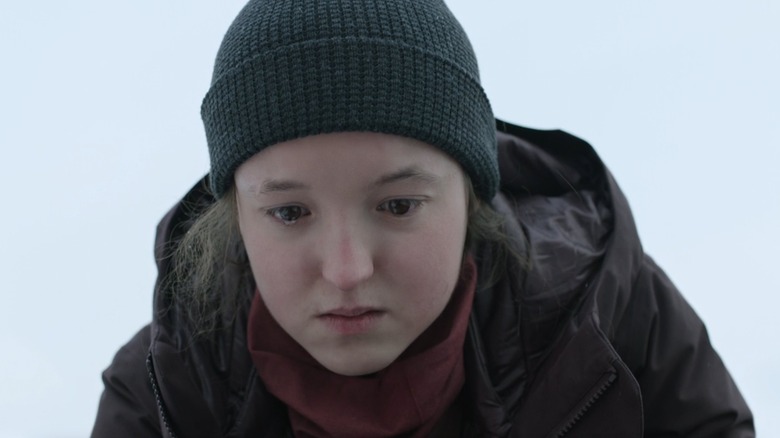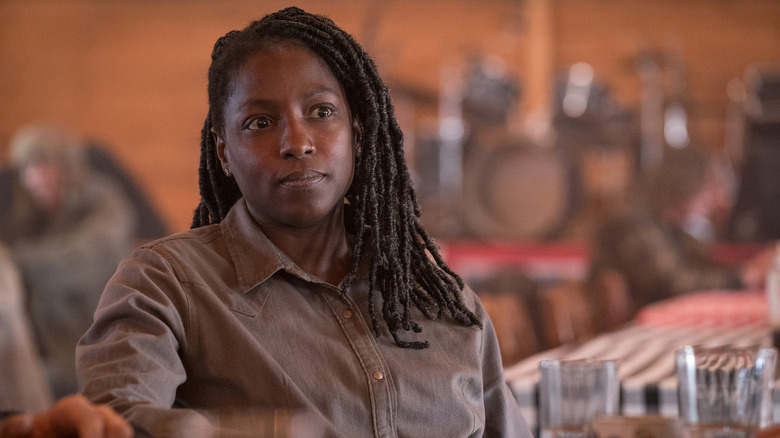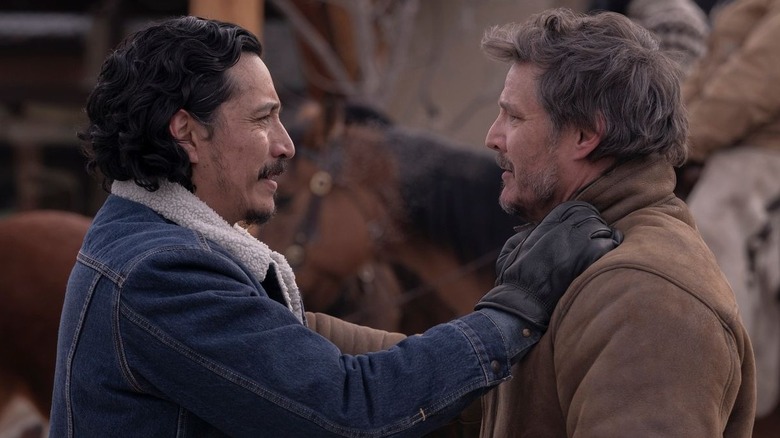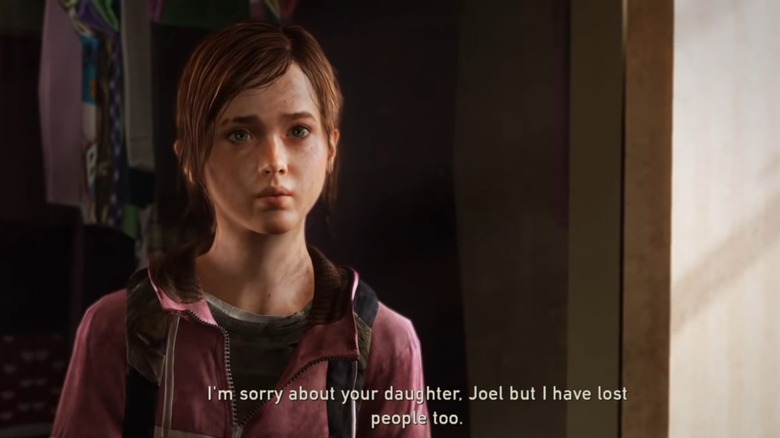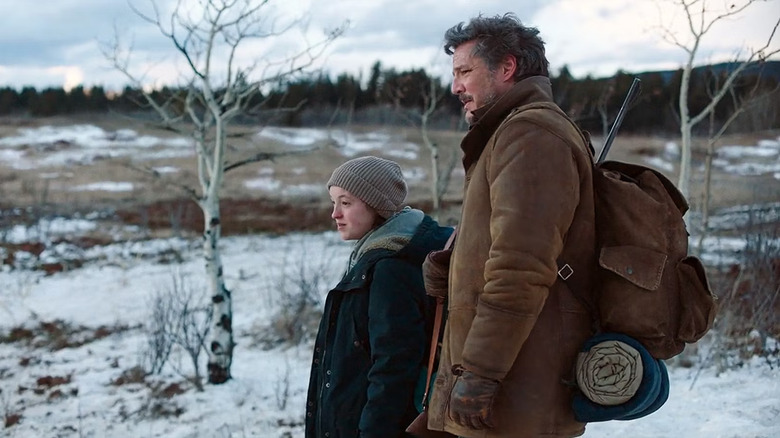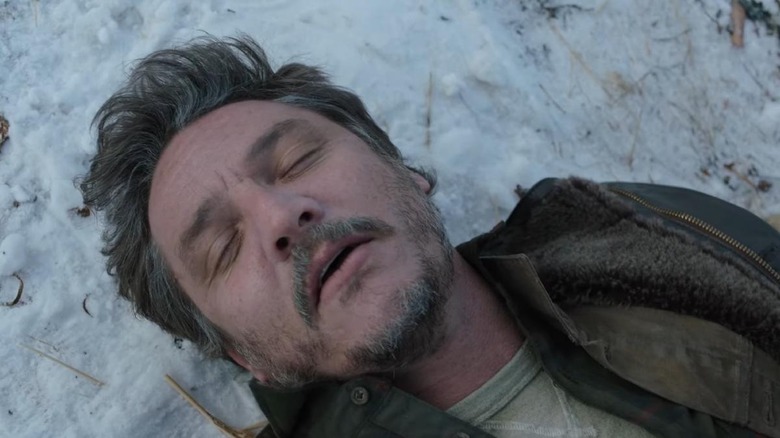How The Last Of Us Episode 6 Compares To The Original Video Game
This article contains spoilers for "The Last of Us."
Episode 6 of "The Last of Us" was the juiciest yet, including multiple Easter eggs for the next season ("The Last of Us Part II" game) as well as a ton of changes compared to this section of the first game.
There were so many delicious little nuggets for players of both games to feast on, from seeing Ellie's (Bella Ramsey) eventual horse Shimmer to a glimpse of a major character in Ellie's story in the second game. This episode was pivotal for introducing narrative tent poles for the second game's story that will be covered next season. I won't spoil everything — part of the beauty of coming to this franchise via the TV series is that you can discover the story for the first time as players did years ago.
But as a player, I'll simply say that this episode is imperative to revisit before the second season begins; a lot of points will come back in those episodes. Here, I will go over only the major changes made from the first game in episode 6.
Maria and the Jackson settlement
The specifics of how and where Joel (Pedro Pascal) and Tommy (Gabriel Luna) have their reunion differ significantly from the game. Originally, Joel and Ellie happen upon the power plant/hydroelectric dam that Tommy and his people were using to power their settlement. They are met by Maria sniping them. In the show, Joel and Ellie are making their way across the River of Death when they are ambushed by armed people on horses, one of which turned out to be Maria (Rutina Wesley). When she discovers who Joel is, she takes the two back to the fully thriving Jackson settlement, which originally wasn't seen until the second game.
Maria explained in the show how no one person is in charge of their "commune." Maria and Tommy happily state that the citizens of the settlement share "collective ownership" of the rewards and responsibilities within their society. Although some of these values are implied when we see more of Jackson in "Part II," the difference in the first game is that Tommy and Maria make clear that Maria (and her father) is in charge. There was a hierarchy in the game, whereas the show is more interested in making Maria and Tommy down to earth.
Compared to her portrayal in the game, the show's Maria is much softer and more welcoming to strangers. She is a mother two-fold in the show when she isn't in the game. She lost her first child presumably post-outbreak and is expecting another with Tommy. The haircut conversation she has with Ellie, wherein she tells Ellie about Sara for the first time, doesn't exist in the game. The game sees Ellie reveal to Joel that Maria told her about Sara in an offscreen conversation.
Talking with Tommy
Joel's conversations with Tommy in the series are also altered substantially from the game. In the game, they generally escalate more quickly, even involving Joel shoving Tommy in a heated moment. As mentioned in the episode 1 comparison, Tommy separated from Joel out of resentment in the games, and that resentment bubbled up when Joel came to ask him to take Ellie to the Fireflies. Game Tommy took issue not only with the things that Joel did when it was just the two of them but the transgressions he believes Joel committed against him.
In the TV show, however, Tommy only seemed to take issue with the killing that they did to survive, saying that in hindsight that there were "other ways." The writers even took his perspective a step further, having Tommy empathize at one point with Joel's past methods to keep them safe. These changes once again reinforce that the show is aiming for mellowed-out versions of the game characters. Less ruthless characters demand more of our sorrow when bad things happen to them. With how tightly the show is mapped to the game, the writers can't spare any opportunity for us to feel for these characters.
The show does this again by scripting Joel to initially lie to Tommy about why he was taking Ellie west. In the game, Joel immediately tells Tommy that Ellie is immune. But in the series, he lies at first, saying that Ellie is the daughter of a Firefly, revealing her immunity to Tommy later. This is a brilliant wrinkle to this relationship because it transcends the surface anger displayed in the game. This white lie, along with assuring Tommy that Tess is alive, shows Joel's fear of opening up — even with his own kin.
Separating from Ellie
This episode introduces tension between Joel and Ellie which leads to a temporary rift, but the degrees of separation were less in the series. After overhearing Joel asking Tommy to take Ellie the rest of the way to the Fireflies in the game, Ellie runs off on horseback in anger. The game then enters a playable section where Joel and Tommy go to find her. Conversely, she never leaves Jackson in the series, despite overhearing the conversation. Without a play element, Joel going on a goose chase for Ellie was unnecessary for the show. Still, once Joel speaks with Ellie after her discovery, the ensuing argument plays out the same way as the game. As it should have — that bedroom scene is the first where we truly hear what Joel means to Ellie, which makes the end of the episode more heartbreaking.
It should also be noted that Joel's reasoning for wanting Tommy to finish the job with Ellie was augmented for the show. Game Joel never really provides a tangible reason for passing Ellie off to Tommy; the most we get is Joel saying he doesn't trust himself and that Tommy knows the area to the west better. But in the show, Joel meanders into a monologue to Tommy about how he dreams about failing "her" repeatedly (failing Ellie? Sara? A mixture of both?), and expresses panic that he will get Ellie killed. He is tearful in this scene, something we never see from Joel in the games after Sara's death.
Staying the course
The show's Joel is fearful in ways that the game's Joel arguably couldn't be given the intensity of the gameplay. (He kills a lot of people because of the nature of the game.) Both versions characterize Joel as repressed emotionally, but the show lets his emotions seep out with more ease. Because let's face it: this is television. Tears win Emmys, especially for men!
Joel's growing soft spot for Ellie shows when he gives her the chance to stay by his side. But, this decision is made in nearly opposite ways comparing versions. In the game, Joel simply has a change of heart after their argument (and fending off intruders together). The TV series sees Joel offer Ellie a choice in the end, even after their argument, and she immediately selects Joel over Tommy.
The semantics of whether Joel chose Ellie or vice versa doesn't matter as much as Joel ultimately offering Ellie a choice. The show version of Joel is more open to democracy with Ellie, whereas the game version is authoritarian, wanting the first and last word on decisions.
Joel's injury
The episode ended on a cliffhanger that will lead to important symbolism to finish the season. Once Ellie and Joel follow the lead Tommy gave them to the University of Eastern Colorado, they discover that there are no Fireflies there ... again. They encounter hunters with hand weapons and, in a scuffle with one, Joel is stabbed in his lower side abdomen with the broken end of a baseball bat. In the game, Joel is impaled in the same place, but with a rebar that pierces all the way through after he falls from a balcony. The show spared us that lovely image and alternatively created a more realistic injury for Joel to recover from. And more importantly, a more believable injury for Ellie to be able to nurse him back to health.
At this point in the story, Joel's injury represents the peak of his vulnerability and closeness to Ellie thus far. Ellie will mend his broken pieces, symbolically filling the hole left by Sara's death in his heart. It is in repayment of this care from Ellie, as well as his growing love for her, that Joel will finally — perhaps inevitably — come to accept Ellie as his surrogate daughter.
